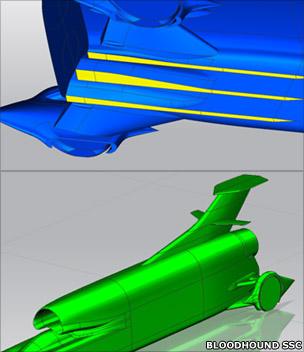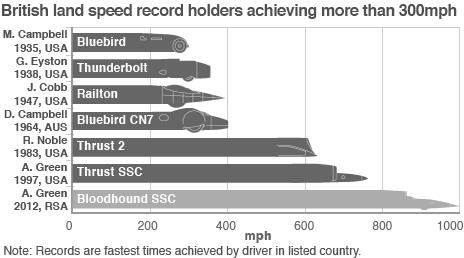Bloodhound diary: Small details left
- Published
RAF fighter pilot Andy Green intends to get behind the wheel of a car that is capable of reaching 1,000mph (1,610km/h).
Powered by a rocket bolted to a Eurofighter-Typhoon jet engine, the Bloodhound car will mount an assault on the land speed record.
Wing Cmdr Green is writing a diary for the BBC News Website about his experiences working on the Bloodhound SSC (SuperSonic Car) project and the team's efforts to inspire national interest in science and engineering.

Three years ago we weren't sure we could reach 1,000mph. We are now
The refinement of Bloodhound SSC's design continues.
We are still working on the final stability balance for the car, looking for the so-called "positive yaw static margin".
In other words, we need to have the aerodynamic centre behind the centre of gravity, so that - just like a dart - the fin keeps the back end behind the (heavier) front end. Simple.

What’s better – bigger fin or under-body strakes?
Some of this work involves lightening the back end, with detailed engineering design to remove weight without weakening the structure. The other half of the equation is to make the car's fin more effective, so we are assessing the merits of an "end-plate" on top of the fin (to make it more effective) and strakes underneath the car.
While we are worrying over these remaining details, it's useful to remember just how far Bloodhound's design has come.
Three years ago we weren't sure we could reach 1,000mph and two years ago we were struggling to find a design that would stay on the ground.
Aerodynamicist Ron Ayers sums up the progress very neatly in his latest aerodynamics update, external. Worrying about the size of the tail fin really is a sign that we're just about there.
Whatever final shape we choose, there's still room to put your name on the car's tail fin, external. Know someone who would like their name to travel at 1000 mph? Now's the time to treat them!
We are grateful to the British Museum of Road Transport in Coventry for the loan of one of Thrust SSC's brake chutes this month. After studying the record-breaking solution from 1997, and applying some new technology to it, our chute experts (SES) think that we will be able to save a lot of weight with an improved design.
Given that the chutes are mounted at the back of the car (for obvious reasons), this will help to move the centre of gravity forwards - so far, so good.

Spring drogue – a simple, reliable way to deploy the brake chute
We are also planning to use a very simple deployment system, the "spring drogue" which forces a small drogue chute out into the airflow using a very simple (and reliable) spring system.
I'm all for making things reliable - the last thing I want is to take the car cross-country at several hundred mph because the chutes didn't work.
The spring system is also much easier to reload between runs - and as we need to do two runs within one hour to set a World Land Speed Record, a quick turnaround is another big bonus.
Below 200mph, the brake chutes have very little effect, so for slow speed (including UK runway tests) the car will use carbon disc brakes. The brakes won't be used at 1,000mph, but they will have to spin at that speed, so we're about to do some spin tests.
We've tried one disc already, which survived at well over 1,000 mph. For the next phase of tests, we're going to compare two different aircraft brake discs: those used for the Typhoon and the F-16.

Typhoon brake discs – if they’re good enough for the Royal Air Force...
When we started this process, I was told that carbon would not survive at these speeds. Apparently not true - now we have a choice of discs.
Preparations for our rocket firings in the UK this summer are going well. The gearbox that will convert 18,000RPM of Cosworth Formula 1 engine power into 11,000RPM of rocket pump drive is now being made by X-TRAC and Newburgh engineering.
With these guys on the case, we can rely on a high-quality product being available shortly.
I can't wait to see these next tests - given that our previous rocket firing, external only used about 300psi to deliver the High Test Peroxide (rocket oxidiser), then over 1,000psi of engine-driven firing is going to be quite something.
It's been quite a month for media coverage as well. In the past couple of weeks, we have been on the front page of Engineer magazine, been the lead innovation article in The Economist, had six pages in GQ magazine and featured on the BBC's Bang Goes the Theory. Not bad coverage for a car that isn't going to run for a year or so yet!

Rocket pump gearbox – how to turn a F1 engine into a pump motor
As part of the BBC's filming, I took the chance to interview our legendary aerodynamicist, Ron Ayers, external.
It feels a little odd to "interview" a close friend on camera, but (as ever) Ron gave a clear and simple explanation of the challenges that we had to solve with the last Land Speed Record, and those that still stand between us and 1,000mph.
This video also adds to our stock of education footage. With almost 4,500 UK schools and colleges now signed up, the Bloodhound Education Programme, external continues to grow - so make sure your local school has signed up.
The Engineering Adventure is accelerating and now's the time to get on board.

- Published28 March 2011
- Published5 March 2011
- Published7 February 2011
- Published21 November 2010
- Published13 November 2010